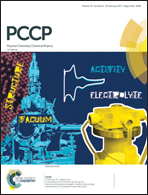Mechanistic insights into CO2 reduction on Cu/Mo-loaded two-dimensional g-C3N4(001)†
Abstract
In this study, DFT-D calculations were performed to explore the role of Cu and Mo loading in the CO2 conversion mechanism on a two-dimensional g-C3N4(001) surface. The introduced transition metals, Cu and Mo, significantly changed the electron distribution and band structures of g-C3N4. Moreover, two possible mechanisms for the reduction of CO2 to CO have been discussed in detail. We found that the energy barriers of the two mechanisms were largely reduced by Cu and Mo loading, and the dominant reaction path changed on different transition metal-loaded surfaces. Cu/g-C3N4(001) prefers to directly dissociate CO2 into CO, whereas cis-COOH is the preferred product of CO2 reduction on Mo/g-C3N4(001). Considering the activation barrier and reaction route selectivity, Mo-doped g-C3N4(001) was identified as a promising candidate for CO2 conversion. It is concluded that suitable transition metal doping can efficiently reduce the energy barrier and control route selectivity along the reaction paths over the g-C3N4 surface. These findings could provide a helpful understanding of the CO2 reduction mechanisms and aid in the molecular design of novel g-C3N4 catalysts for CO2 conversion.



 Please wait while we load your content...
Please wait while we load your content...